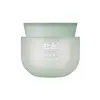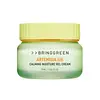What's inside
What's inside
 Key Ingredients
Key Ingredients

 Benefits
Benefits

 Concerns
Concerns

 Ingredients Side-by-side
Ingredients Side-by-side

Water
Skin ConditioningGlycerin
HumectantButylene Glycol
HumectantMethyl Trimethicone
Skin ConditioningDicaprylyl Ether
EmollientArtemisia Argyi Leaf Extract
Skin ConditioningBetaine
HumectantCetyl Ethylhexanoate
EmollientHydrogenated Poly(C6-14 Olefin)
EmollientGlyceryl Polymethacrylate
1,2-Hexanediol
Skin ConditioningGlyceryl Stearate Citrate
EmollientCnidium Officinale Root Water
MaskingAngelica Acutiloba Root Extract
Skin ConditioningAmmonium Acryloyldimethyltaurate/Vp Copolymer
C14-22 Alcohols
Emulsion StabilisingHydroxyethyl Acrylate/Sodium Acryloyldimethyl Taurate Copolymer
Emulsion StabilisingPolymethylsilsesquioxane
Arachidyl Alcohol
EmollientStearic Acid
CleansingGlyceryl Stearate
EmollientButyrospermum Parkii Butter
Skin ConditioningPalmitic Acid
EmollientBehenyl Alcohol
EmollientDioscorea Japonica Root Extract
Skin ConditioningC12-20 Alkyl Glucoside
EmulsifyingRubus Idaeus Fruit Extract
AstringentUlmus Davidiana Root Extract
Skin ConditioningArachidyl Glucoside
EmulsifyingParfum
MaskingEthylhexylglycerin
Skin ConditioningSalicornia Herbacea Extract
Skin ConditioningMorus Alba Leaf Extract
Skin ConditioningAngelica Keiskei Extract
AntioxidantDisodium EDTA
Sorbitan Isostearate
EmulsifyingMyristic Acid
CleansingLauric Acid
CleansingTocopherol
AntioxidantGlycine Soja Oil
EmollientWater, Glycerin, Butylene Glycol, Methyl Trimethicone, Dicaprylyl Ether, Artemisia Argyi Leaf Extract, Betaine, Cetyl Ethylhexanoate, Hydrogenated Poly(C6-14 Olefin), Glyceryl Polymethacrylate, 1,2-Hexanediol, Glyceryl Stearate Citrate, Cnidium Officinale Root Water, Angelica Acutiloba Root Extract, Ammonium Acryloyldimethyltaurate/Vp Copolymer, C14-22 Alcohols, Hydroxyethyl Acrylate/Sodium Acryloyldimethyl Taurate Copolymer, Polymethylsilsesquioxane, Arachidyl Alcohol, Stearic Acid, Glyceryl Stearate, Butyrospermum Parkii Butter, Palmitic Acid, Behenyl Alcohol, Dioscorea Japonica Root Extract, C12-20 Alkyl Glucoside, Rubus Idaeus Fruit Extract, Ulmus Davidiana Root Extract, Arachidyl Glucoside, Parfum, Ethylhexylglycerin, Salicornia Herbacea Extract, Morus Alba Leaf Extract, Angelica Keiskei Extract, Disodium EDTA, Sorbitan Isostearate, Myristic Acid, Lauric Acid, Tocopherol, Glycine Soja Oil
Artemisia Capillaris Extract
Water
Skin ConditioningGlycerin
HumectantMethylpropanediol
Solvent1,2-Hexanediol
Skin ConditioningBetaine
HumectantVinyldimethicone
Isopropyl Palmitate
EmollientCaprylyl Methicone
Skin ConditioningHydrogenated Poly(C6-14 Olefin)
EmollientPhellodendron Amurense Bark Extract
Skin ConditioningHydrolyzed Gardenia Florida Extract
AntioxidantMacadamia Ternifolia Seed Oil
EmollientCitrus Aurantium Dulcis Peel Oil
MaskingSodium Hyaluronate
HumectantCymbopogon Martini Oil
MaskingOlea Europaea Fruit Oil
MaskingCananga Odorata Flower Oil
MaskingPelargonium Graveolens Flower Oil
MaskingCedrus Atlantica Bark Oil
MaskingFerula Galbaniflua Resin Oil
AntimicrobialRosa Damascena Flower Oil
MaskingPolymethylsilsesquioxane
Hydroxyethyl Acrylate/Sodium Acryloyldimethyl Taurate Copolymer
Emulsion StabilisingHydrogenated Polydecene
EmollientDimethiconol
EmollientAcrylates/C10-30 Alkyl Acrylate Crosspolymer
Emulsion StabilisingTromethamine
BufferingGlyceryl Acrylate/Acrylic Acid Copolymer
HumectantXanthan Gum
EmulsifyingCeramide NP
Skin ConditioningCandida Bombicola/Glucose/Methyl Rapeseedate Ferment
AntimicrobialPolyglyceryl-10 Stearate
Skin ConditioningSorbitan Isostearate
EmulsifyingDisodium EDTA
Cetearyl Alcohol
EmollientSodium Stearoyl Glutamate
CleansingMaltodextrin
AbsorbentEthylhexylglycerin
Skin ConditioningLimonene
PerfumingGeraniol
PerfumingArtemisia Capillaris Extract, Water, Glycerin, Methylpropanediol, 1,2-Hexanediol, Betaine, Vinyldimethicone, Isopropyl Palmitate, Caprylyl Methicone, Hydrogenated Poly(C6-14 Olefin), Phellodendron Amurense Bark Extract, Hydrolyzed Gardenia Florida Extract, Macadamia Ternifolia Seed Oil, Citrus Aurantium Dulcis Peel Oil, Sodium Hyaluronate, Cymbopogon Martini Oil, Olea Europaea Fruit Oil, Cananga Odorata Flower Oil, Pelargonium Graveolens Flower Oil, Cedrus Atlantica Bark Oil, Ferula Galbaniflua Resin Oil, Rosa Damascena Flower Oil, Polymethylsilsesquioxane, Hydroxyethyl Acrylate/Sodium Acryloyldimethyl Taurate Copolymer, Hydrogenated Polydecene, Dimethiconol, Acrylates/C10-30 Alkyl Acrylate Crosspolymer, Tromethamine, Glyceryl Acrylate/Acrylic Acid Copolymer, Xanthan Gum, Ceramide NP, Candida Bombicola/Glucose/Methyl Rapeseedate Ferment, Polyglyceryl-10 Stearate, Sorbitan Isostearate, Disodium EDTA, Cetearyl Alcohol, Sodium Stearoyl Glutamate, Maltodextrin, Ethylhexylglycerin, Limonene, Geraniol
Ingredients Explained
These ingredients are found in both products.
Ingredients higher up in an ingredient list are typically present in a larger amount.
1,2-Hexanediol is a synthetic liquid and another multi-functional powerhouse.
It is a:
- Humectant, drawing moisture into the skin
- Emollient, helping to soften skin
- Solvent, dispersing and stabilizing formulas
- Preservative booster, enhancing the antimicrobial activity of other preservatives
Betaine is a common humectant (a substance that promotes retention of moisture). It's known to be gentle on the skin and can help balance hydration.
This ingredient is best for improving hydration and soothing irritated skin. Studies also show it helps even out skin tone.
Fun fact: Betaine is naturally created in the skin and body. The kind found within cosmetic products can be either plant-derived or synthetic.
Another name for betaine is trimethylglycine.
Learn more about BetaineDisodium EDTA plays a role in making products more stable by aiding other preservatives.
It is a chelating agent, meaning it neutralizes metal ions that may be found in a product.
Disodium EDTA is a salt of edetic acid and is found to be safe in cosmetic ingredients.
Learn more about Disodium EDTAEthylhexylglycerin (we can't pronounce this either) is commonly used as a preservative and skin softener. It is derived from glyceryl.
You might see Ethylhexylglycerin often paired with other preservatives such as phenoxyethanol. Ethylhexylglycerin has been found to increase the effectiveness of these other preservatives.
Glycerin is already naturally found in your skin. It helps moisturize and protect your skin.
A study from 2016 found glycerin to be more effective as a humectant than AHAs and hyaluronic acid.
As a humectant, it helps the skin stay hydrated by pulling moisture to your skin. The low molecular weight of glycerin allows it to pull moisture into the deeper layers of your skin.
Hydrated skin improves your skin barrier; Your skin barrier helps protect against irritants and bacteria.
Glycerin has also been found to have antimicrobial and antiviral properties. Due to these properties, glycerin is often used in wound and burn treatments.
In cosmetics, glycerin is usually derived from plants such as soybean or palm. However, it can also be sourced from animals, such as tallow or animal fat.
This ingredient is organic, colorless, odorless, and non-toxic.
Glycerin is the name for this ingredient in American English. British English uses Glycerol/Glycerine.
Learn more about GlycerinWe don't have a description for Hydrogenated Poly(C6-14 Olefin) yet.
This is a synthetic polymer. It helps improve the texture of products by adding thickness and gel-like feel.
It is also an emulsifer, meaning it prevents ingredients such as oil and water from separating. It also helps evenly disperse other ingredients.
Polymethylsilsesquioxane is a silicone used as a film forming agent.
When applied to the skin, this ingredient creates an invisible film on the surface. This film still allows oxygen to pass through, but prevents moisture from escaping. This can help condition and hydrate the skin. It also leaves a silky feel when applied.
Polymethylsilsesquioxane has not been shown to clog pores. It has been deemed safe to use up to 55%, but most cosmetics use much less.
If you have concerns about using this ingredient, we recommend speaking with a professional.
Learn more about PolymethylsilsesquioxaneSorbitan Isostearate is an emulsifer and cleaning agent. It is created from isostearic acid and sorbitol.
As an emulsifier, Sorbitan Isostearate prevents oils and water from separating.
Due to its isostearic acid base, it may not be safe for Malassezia or fungal acne.
Learn more about Sorbitan IsostearateWater. It's the most common cosmetic ingredient of all. You'll usually see it at the top of ingredient lists, meaning that it makes up the largest part of the product.
So why is it so popular? Water most often acts as a solvent - this means that it helps dissolve other ingredients into the formulation.
You'll also recognize water as that liquid we all need to stay alive. If you see this, drink a glass of water. Stay hydrated!
Learn more about Water